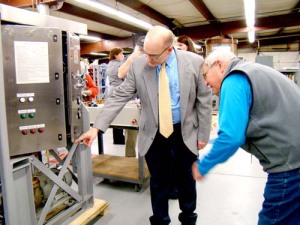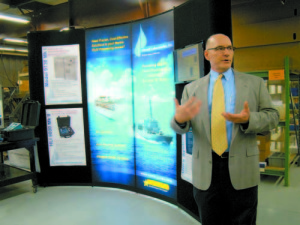Golden moment: After 50 years, Howell Labs is a success story

THE LATEST TECHNOLOGY — John Bliss, vice president of product development at Howell Labs, explains the workings behind one of the company’s seawater chlorinator machines. Howell products, also including dehydrators and humidity measuring equipment, can be found on virtually every class of blue water surface ships and submarines in both the Navy and Army.
(Geraghty Photo)
By Gail Geraghty
Staff Writer
The festive atmosphere at Thursday’s 50th anniversary celebration at Howell Laboratories, Inc., came first and foremost from all of its employees. And why not?
After all, they own the place.
The fact that the antennae and water purifications systems manufacturer is one of just a few 100% employee-owned businesses in the state, however, is just one of the reasons it stands out as perhaps the single most remarkable business success story in Bridgton.
Not many businesses in town or anywhere in the state can claim to be a national, let alone a worldwide leader in the products it makes, nor can it claim the U.S. Government as one of its biggest customers. Yet that has been the case, ever since Howell and Shively, the two divisions that form the basis of the company, were founded in 1964.
The company’s reputation for excellence and quality has not gone unnoticed. In 2012, Shively was recognized by the Small Business Administration as Maine's Exporter of the Year. In 2013, Howell was named the SBA's New England Subcontractor of the Year, an award they were nominated for by Bath Iron Works.
Long journey
In his welcoming remarks, Howell Labs President David Allen said it’s been a long journey since the company began under much humbler circumstance in space in the former Gibbs Avenue schoolhouse. A former Howell executive, Bridgton resident Steve Collins, was among those attending the gathering, and he said he could attest to the humble beginnings.
“You could see right through the clapboards,†joked Collins, who was one of several Howell retirees who attended the celebration. Also on hand was Betty Shively, whose late husband Ed Shively founded Shively Labs, and their son Jim Shively, who also worked there.
Culture of ownership
“My dad started with a vision, and we watched him put his heart and soul into it every day,†said Jim Shively. Today Shively designs and manufactures the world’s leading technology in FM broadcasting equipment, with its biggest customer being the U.S. State Department. It has supplied over 8,000 antennas to more than 80 countries, to sites atop tall buildings in major cities to remote arctic villages and unmanned extreme weather sites at high elevations.
“I’m most proud of the fact that he (Ed Shively) talked to all of us like we were his peers,†said Jim Shively. “It was a group of peers trying to solve a problem.â€
That culture and spirit of equal participation and ownership became a reality in 1995, when Howell/Shively became one of the first companies in Maine to be employee-owned by a majority of its employees. The company became 100% employee-owned in 2013, and is one of only 13 companies in Maine that are members of the Employee Stock Ownership Plan (ESOP) Association.

PROUD TO BE THERE — Howell’s Vice President of Product Development, Engineering Group John Bliss explains the many types of fluid treatment technologies and commercial marine products the company supplies to the maritime industry, particularly the U.S. Navy.
(Geraghty Photo)
Allen echoed the pride he takes in the employee-ownership status of the company, which currently employs around 60 people who live in 20 towns in Maine and New Hampshire, plus Oregon.
“Employee ownership is very important to us, and I’m glad (those attending the celebration) were able to experience it first-hand,†Allen said. He said Howell employees have extensive access to company financial and performance metrics, and hold monthly meetings to update everyone on performance and answer questions.
Diversification
When Howell acquired and merged with Shively in 1980, Howell’s largest customer was overwhelmingly the U.S. Navy. Despite the success it was having, said Allen, they felt the need to expand into commercial markets as a hedge against the impact of inevitable government downturns.
Allen attributes a large part of the company’s success over the years to a “strategy of having one foot in each of the military and commercial broadcast markets.†That, he said, and “being nimble†when it came to competing with larger companies in bidding on contracts.
Allen said the business strategy has meant that the two divisions need to remain largely autonomous, with unique cultures and concerns, indefinitely. The companies were physically merged in 1981 at the Route 117 facility, which was later expanded in 1985.
Along the way, said Allen, Howell has acquired a few companies, some of which they spun off again, some of which they kept. The largest of these was Microwave Techniques in Raymond, which merged with Howell in 1987. At its peak, Howell/Shively/Microwave employed more than 250 people at four facilities in Bridgton, Raymond, South Casco, and St. Stephen, New Brunswick.
Allen said Howell dehydrators can be found on every large surface combatant in the U.S. Navy and Howell products can be found on virtually every class of blue water surface ships and submarines in both the Navy and Army.
The company regularly responds to natural disasters around the world, Allen said. “Our antennas provide valuable communications capacity and our water purification equipment is deployed as part of Navy task forces to supply drinking water. It is not uncommon for the design cycle for our products from proposal through approvals to production to take eight years or more.â€

